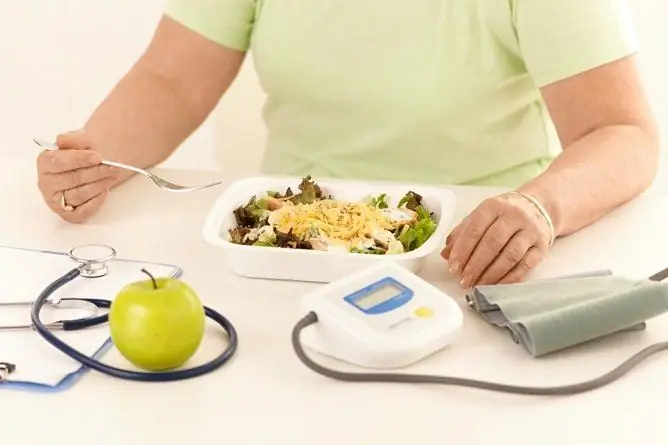Measuring blood sugar at home
The content of the article:
- Types of blood glucose meters
- Glucometer device
- Blood sugar measurement technique
- Recording and analytics of test results
Measurement of blood sugar and, if necessary, its timely correction is required to prevent the development of severe complications of diabetes mellitus. Since glycemic control must be constant, patients with diabetes are taught to do it themselves at home. For this purpose, portable devices for measuring blood sugar - glucometers are used. Such devices make it possible to monitor blood glucose levels not only in diabetics, but also in healthy people, if necessary.

Portable blood glucose meter allows you to monitor your blood sugar at home
Analysis of the results of measuring blood sugar allows you to evaluate the effectiveness of therapy, determine the correct strategy for each stage of treatment and lifestyle, optimize the energy value of food intake, promptly make changes, adjust the diet and dosage of drugs.
Types of blood glucose meters
There are several types of blood glucose meters:
- photochemical glucometers - measure the amount of glucose in the blood in accordance with the change in the color of the reagent. The blood from the finger is mixed with special substances applied to the test strip. Blood glucose enters into a chemical reaction with the reagent, the reagent turns blue, while the intensity of the shade will depend on the glucose concentration. The optical system of the device analyzes the change in the test zone and gives the result in digital terms on the display. The photochemical method has drawbacks and is considered obsolete;
- electrochemical glucometers - record blood glucose levels by measuring the amount of electric current released during the reaction. Glucose interacts with the reaction zone of the test strip, which contains a mixture of dry reagents, resulting in a weak electric current, the value of which is analyzed by the measuring device of the device. The results are displayed on the screen as a glucose reading. Electrochemical devices are more accurate than photochemical devices and belong to the third generation of glucometers.
Several other types of glucometers are under development and implementation - optical biosensors operating on the basis of surface plasma resonance, and spectrometric glucometers, which measure blood sugar levels by scanning the patient's palm. Such a device makes it possible to determine glucose content without taking blood, using a laser.
Glucometer device
A classic blood glucose meter consists of the following elements:
- accumulator battery;
- finger piercing tool - semi-automatic scarifier (lancet);
- electronic unit equipped with a liquid crystal display;
- unique set of test strips.
Glucometers may vary in size, speed, memory and screen parameters, and cost. Modern glucometers are compact, accurate, have a high speed of obtaining a result, do not require complicated maintenance, and only a small amount of capillary blood, that is, taken from a finger, is needed to use them.
Modern models can be equipped with useful additional features:
- memory;
- computerization of results;
- the ability to save the latest results;
- separate keeping of statistics;
- calculating the average blood sugar level for a certain period;
- control of ketone bodies in the blood;
- auto-encoding of test strips;
- voice function.
All meters measure blood sugar differently and give different results. Each device is calibrated (set) against a glucose standard solution. Once calibrated, each batch of strips receives a unique numeric code that is entered into the meter. The meter needs to be calibrated against the test strips. On some meters, the code must be entered manually for each new batch of test strips, on other meters, the code is entered automatically.
To compare the results of different blood sugar machines, you need to know the true blood glucose value, which only a laboratory analyzer can determine. The best way to test the accuracy of your home blood glucose meter is to compare your individual meter results with your laboratory values each time you visit your doctor.
Blood sugar measurement technique
The choice of time for measuring blood sugar with a glucometer and the frequency of the analysis are selected by the doctor based on individual indications. In non-insulin dependent types of diabetes, blood sugar is usually measured twice a day.
The minimum frequency of glycemic control in insulin-dependent types of diabetes is four times a day. The more often blood sugar is measured, the more information is available about the effectiveness of drug therapy and about the factors that contribute to lowering blood glucose levels. In case of instability of glycemia, experts recommend that patients taking insulin measure blood sugar in the morning and before bedtime, before and after meals, before playing sports, as well as in non-standard situations: before performing actions requiring a high concentration of attention, with concomitant diseases, unmotivated deterioration well-being, in stressful situations, with changes in the usual rhythm of life, pregnancy.
It is not recommended to eat four hours before the test. The test is usually done before meals and at bedtime.
Analysis algorithm:
- wash your hands with soap and warm water and dry them with a clean towel. It is not worth treating your hands with disinfection solutions, alcohol-containing liquids or wet wipes, in this case there is a high probability of getting an erroneous result;
- warm your fingers to room temperature, lightly massage your hands to improve blood circulation;
- install a sterile needle in the scarifier;
- remove the test strip from the sealed vial;
- fasten the test strip to the socket of the meter;
- turn on the meter, while on the display after checking the coding and the expiration date of the test strip, a message appears on the readiness for use;
- choose the optimal puncture depth, taking into account individual sensitivity and skin thickness;
- make a puncture on the skin on the side of the finger using a lancing device. It is recommended to use different puncture sites for blood sampling;
- place a drop of blood in the area where the test strip is applied;
- apply a cotton swab soaked in alcohol solution to the puncture site;
- remove the test strip from the machine.
When the required amount of blood is received, the device displays a corresponding message on the screen and starts diagnostics. Test results will be ready in 5-50 seconds.
Errors when measuring blood sugar with a glucometer:
- Using test strips designed for a different model of blood glucose meter
- non-observance of the temperature regime when taking blood (too low or high air temperature in the room, cold hands);
- dirty hands or test strips;
- shallow puncture, a lot or little blood for analysis;
- getting into the blood of a solution for disinfection, water;
- contamination or damage to the meter;
- lack of verification of the accuracy of the device, incorrectly set test strip code;
- improper storage of test strips (loosely closed vial, storage temperature too high or too low, storage longer than the shelf life).
Recording and analytics of test results
Recording the results of measuring blood sugar at home is extremely important, it allows you to react in time to changes in the body, assess how the balance of calories from food intake affects blood glucose levels, choose the optimal physical activity, and adjust insulin doses.

It is recommended that you keep a self-test log that records your blood glucose results
It should be remembered that the norm of blood sugar in adults ranges from 3.3–5.5 mmol / l. A blood sugar level of 7.8-11.0 is characteristic of prediabetes, an increase in glucose concentration of more than 11 mmol / l indicates diabetes mellitus. Experts recommend that diabetics keep their sugar in the range of 5.5–6.0 mmol / L. Additionally, the general condition of the endocrine system, the presence of minor diseases, the age and gender of the patient are taken into account.
To record the results of measuring blood sugar, you can create a special table or use ready-made forms of self-control logs. Modern models of glucometers have the ability to connect to a computer and the function of automatic recording and processing of measurement results. Computer applications are able to analyze measurement results, visualize indicators for a certain period of time in the form of charts or graphs.
The self-control log contains information about the time of blood sugar measurement, doses of insulin and other medications taken, blood pressure level, body weight, schedule of physical activities, information about food, emotional state.
For a meaningful analysis of blood glucose levels, it is recommended to carry out the so-called pair testing, in which the blood sugar is measured before and after a specific event or activity. So, measuring blood sugar before and after a meal will help to understand how correctly a food diet or individual food items are chosen. Comparison of readings taken in the evening and in the morning will show the changes in the level of glucose in the body during sleep.
YouTube video related to the article:

Anna Kozlova Medical journalist About the author
Education: Rostov State Medical University, specialty "General Medicine".
Found a mistake in the text? Select it and press Ctrl + Enter.







